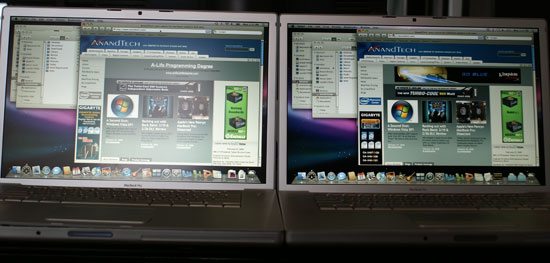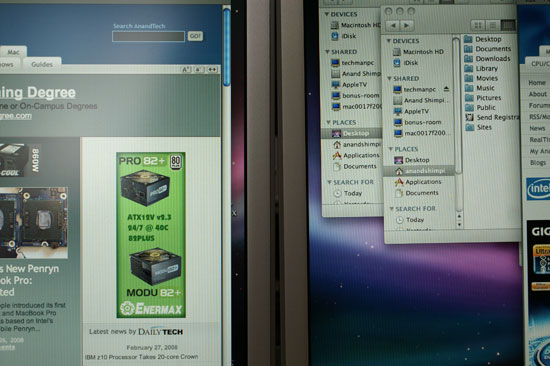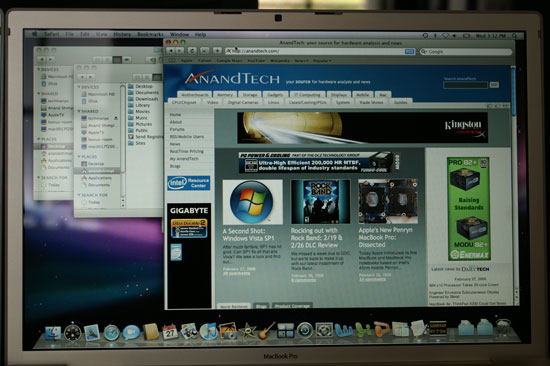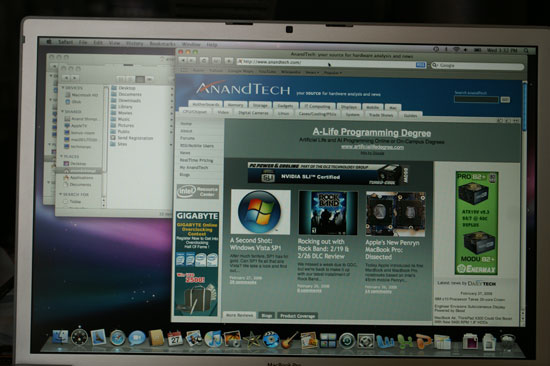Apple’s 45nm Refresh: New MacBook & MacBook Pro
by Anand Lal Shimpi on February 29, 2008 12:00 AM EST- Posted in
- Mac
Glossy or Not?
With the exception of the MacBook Pro, all of Apple’s notebooks are available exclusively with a glossy display. The benefit of a glossy display is an improved contrast ratio but the downside is it reflects more ambient light, particularly when you have an unusually strong light source (e.g. sitting in front of a window or being outside with the Sun).
With the MacBook Pro you have the option of either a glossy or anti-glare display, the question that remains is: which should you choose?
As you’d expect, the decision really falls upon your intended use for the notebook. Indoors, the glossy display was much nicer in my opinion. Blacks appeared blacker and the screen was much more pleasant to look at:

Matte screen (left) vs. Glossy (right)

Matte screen (left) vs. Glossy (right)
Unfortunately the glossy screen can get pretty annoying when there's glare on it:

Glossy, see the window reflection on the left?
The matte anti-reflective screen just gets a little washed out but doesn't reflect its environment when presented with glare:

I still end up preferring the glossy screen but I don't use these things outside that often. If I were still using them outside on campus I might have to opt for the matte screen instead.
Cases, we need Cases
I can’t stress how important it is for Apple to start building good cases for its notebooks. Apple has done a tremendous job on styling its notebooks yet they are confined to the same cases that even the most generically designed PC notebooks are destined for. Many of Apple’s notebook peripherals are also not of standard shapes or sizes (e.g. the power brick), paving the way for even more synergy through a well designed custom case.
The MacBook Air needs a custom case to avoid losing the point of one of its biggest features. Who cares if you can stick the Air in a manilla folder if you have to carry it around in a standard laptop bag?
The MacBook and MacBook Pro are no different, although not as extreme of examples as the Air. These notebooks feature a very well proportioned shape and are as attractive as you can get in a computer (I’ll refrain from using the word sexy since, well, they don’t incite any sexual desire despite being well styled computers), yet they are carried in ugly, not well designed bags.
Apple seems to have the design sense to tackle such a thing, although I’m not sure if it really wants to get into the notebook case business. I figure that it spends so much time and effort on making sure its packaging is among the most stylish on the planet, why not create some packaging that you can actually take with you?










51 Comments
View All Comments
myusernamehere - Friday, February 29, 2008 - link
either of the displays led backlit?DavidK - Friday, February 29, 2008 - link
There's been numerous complaints about the Agere firewire chipset in the previous version of the MacBook Pro. Has it been replaced with the TI set, or is it still the Agere?Tigerotor77w - Friday, February 29, 2008 - link
You compared the 2.4 GHz Penryn to the 2.2 GHz Merom, but what about the 2.4 Penryn to the 2.4 Merom? If I'm looking solely at clock speeds, how do those two compare?Additionally, is it conceivable that the $1999 price point remain for the Montevina-based MBPs?
Sunrise089 - Friday, February 29, 2008 - link
Good point, but he compared the notebooks he physically possessed. As in, he bought each of the tested models at one point or another.I strongly believe any future Macbook or Macbook Pro will keep a pricing model determined by the marketing department. Apple has no direct competition (mobile OSX market) so they can simply select the hardware to include that allows them to keep the margins they want.
Tigerotor77w - Saturday, March 1, 2008 - link
Makes sense. Nevertheless, I'm curious how the two 2.4 GHz processors compare (I saw that gizmodo had a comparison, but I'm not sure how that plays out qualitatively).As for the price point, what you said certainly makes sense -- I'm wondering whether they'll keep the $1999 point. Will they give up the sub-$2000 market for 15" notebooks? Or will they want the higher margins on the $2499 MBP?
HopJokey - Friday, February 29, 2008 - link
Anand,In your article you mentioned that Yonah was built on 90nm technology when in fact it is built on 65nm manufacturing. Thanks.
slashbinslashbash - Friday, February 29, 2008 - link
I don't think so Anniend. You want me to do things to you like the sun and the moon. Idiot!acejj26 - Friday, February 29, 2008 - link
My becomes once the battery ages and no longer manages to hold a full charge.Umm??
acejj26 - Friday, February 29, 2008 - link
on page 6, you wrote "blacklit" not backlitGary Key - Friday, February 29, 2008 - link
Fixed. :)